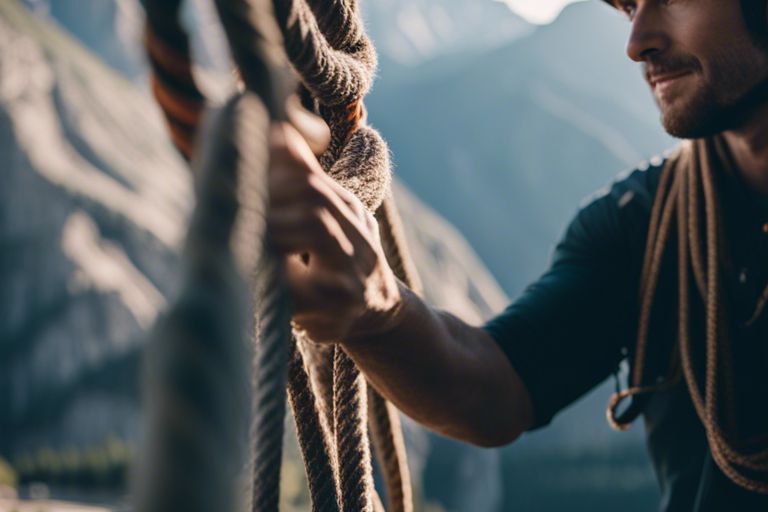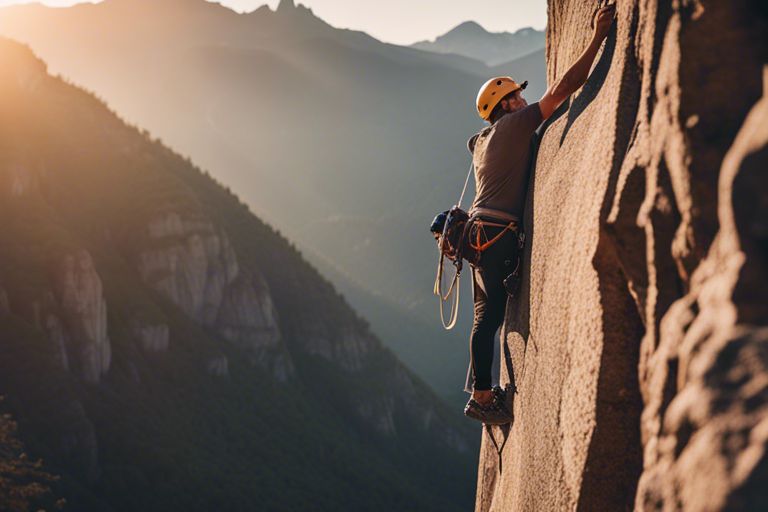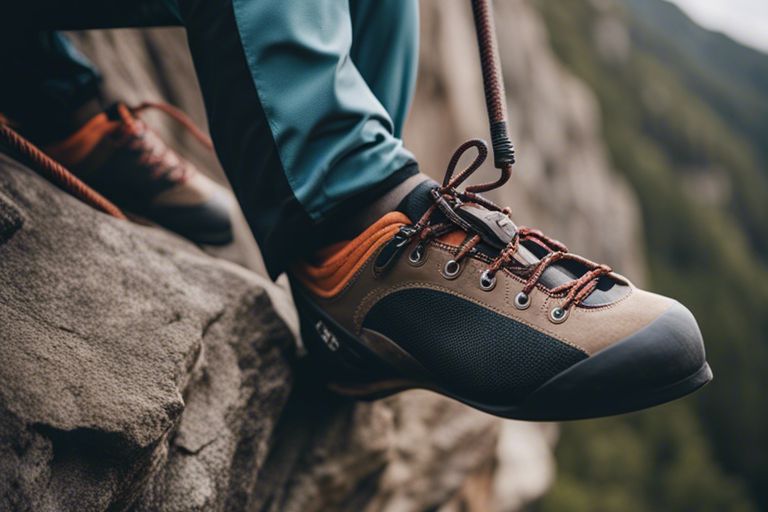There’s an overwhelming array of climbing ropes available, making it crucial to select the right one for your rock climbing adventures. Your safety greatly depends on this choice, so considering factors like rope diameter, length, and type of climbing you’ll be doing is important. Let’s break down the key considerations to help you confidently choose the perfect climbing rope for your next ascent.
Key Takeaways:
- Know the different types of climbing ropes: Understanding the various types of climbing ropes available, such as dynamic ropes for general climbing and static ropes for specific situations, will help you choose the right one for your needs.
- Consider the rope’s diameter and length: The diameter of the rope affects its durability and handling, with thinner ropes being lighter but less durable. The length of the rope should match the climbing routes you plan to tackle.
- Look for important features: Pay attention to key features like the rope’s UIAA fall rating, impact force, and dry treatment, which can affect the rope’s performance, safety, and durability when rock climbing.

Understanding Your Climbing Needs
Identifying Your Climbing Style
Assuming you are new to rock climbing, it’s vital to identify your climbing style before choosing a rope. Are you interested in top-roping, sport climbing, trad climbing, or a combination of these activities? Your choice will influence the diameter, length, and features of the rope that will best suit your needs. Top-roping, for example, may require a different type of rope compared to trad climbing due to the frequency of falls and wear on the rope.
Determining Your Rope Length Requirements
Any climbing rope you purchase should be long enough to accommodate the routes you intend to climb. The standard length for most climbing ropes is between 60 to 70 meters. If you plan on climbing longer routes or multi-pitch climbs, you may need a longer rope. Keep in mind that longer ropes are heavier and may be more cumbersome to carry, so it’s vital to strike a balance between length and practicality.
Rope length requirements can also vary depending on the climbing area or route you frequent. Some routes may require a specific length of rope for rappelling or lowering off, so it’s crucial to research the climbing area and route requirements before making a purchase.
Key Factors to Consider
Some key factors to consider when choosing a climbing rope for rock climbing include rope material, rope diameter, and rope construction. Each of these factors plays a crucial role in determining the performance and safety of the rope while you’re out on the rocks.
Rope Material: Nylon vs. Polyester
Material is an imperative factor to consider when selecting a climbing rope. The two most common materials used in climbing ropes are nylon and polyester. Nylon ropes are known for their stretchiness, which can be advantageous in absorbing the shock of a fall. On the other hand, polyester ropes are less stretchy but are more durable and resistant to abrasion. When choosing between nylon and polyester, consider your climbing preferences and the type of climbing you’ll be doing.
Rope Diameter: Thicker vs. Thinner
Rope diameter is another critical factor to consider when buying a climbing rope. Thicker ropes typically offer more durability and are easier to handle, making them ideal for beginners or top-roping. Thinner ropes are lighter and more suitable for advanced climbers looking to reduce weight and drag. The choice between a thicker or thinner rope depends on your climbing style and preference.
The diameter of the rope also affects its impact force rating and handling. Thicker ropes have a higher impact force rating, which means they can absorb more energy in a fall. Thinner ropes, on the other hand, have a lower impact force rating but may be less durable against abrasion. Consider these factors when choosing the diameter of your climbing rope.
Rope Construction: Braided vs. Twisted
There’s a difference in construction between climbing ropes. Some ropes are braided, while others are twisted. Braided ropes tend to be more flexible and smoother, making them easier to handle and knot. Twisted ropes, on the other hand, can be more durable and have a better resistance to abrasion. When deciding between braided and twisted ropes, consider your handling preferences and the type of climbing you’ll be doing.
Factors such as flexibility, durability, and handling should be considered when choosing between braided and twisted ropes. Each construction type has its advantages and disadvantages, so make sure to select the one that best suits your climbing needs.
Safety Considerations
Now, when choosing a climbing rope for rock climbing, safety should be your top priority. There are several key factors to consider when it comes to the safety of your climbing rope.
UIAA Certification: What It Means
Even if you’re new to climbing, you’ve probably heard of the UIAA (International Climbing and Mountaineering Federation). When a rope has a UIAA certification, it means that it has passed stringent safety tests conducted by the UIAA. This certification ensures that the rope meets certain standards for safety and performance, giving you peace of mind when you’re out on the rocks.
Fall Ratings: Understanding the Numbers
For fall ratings, you’ll often see two numbers associated with a climbing rope, such as 5 UIAA falls and 8 UIAA falls. The first number refers to the number of standard test falls the rope can withstand before it fails, while the second number indicates a range of falls the rope can endure before showing signs of wear. Understanding these numbers is crucial in determining the durability and safety of the rope you choose.
For more advanced climbers or those tackling challenging routes, a higher fall rating may be preferable to ensure greater safety margins in case of falls.
Rope Durability: Assessing Wear and Tear
Another important aspect to consider when it comes to safety is the durability of the climbing rope. Over time, ropes can wear out due to repeated use, exposure to elements, and general wear and tear. It’s necessary to regularly inspect your rope for any signs of damage, such as fraying, cuts, or soft spots, as these can compromise its safety and integrity.
Durability is key when it comes to ensuring the safety of your climbing rope. Regularly inspecting your rope and knowing when to retire it can prevent accidents and keep you safe during your climbs.
To maximize the lifespan of your rope, store it properly, avoid stepping on it, and always use rope protectors when climbing on rough surfaces.
Performance Features
Rope Stretch: Dynamic vs. Static
Features rope stretch is an important consideration when choosing a climbing rope. Dynamic ropes are designed to stretch under tension, which can help absorb the force of a fall and reduce the impact on you. This is especially important for lead climbing where falls can be more frequent. On the other hand, static ropes have minimal stretch and are better suited for activities like rappelling or top-roping where stretch is not as crucial.
Rope Handling: Smooth vs. Rough
Little things like the texture of a rope can make a big difference in how it feels in your hands. Smooth ropes tend to run through belay devices more easily, making for a smoother descent or belay. Rough ropes, on the other hand, can provide better grip, especially in wet conditions or when wearing gloves.
To get a feel for what type of rope handling you prefer, it’s a good idea to test out a few different ropes before making a purchase. Consider the types of climbing you’ll be doing most often and choose a rope that complements your style.
Rope Weight: Lighter vs. Heavier
Static ropes are typically heavier due to their construction, which can make them more durable and long-lasting. However, this added weight can be a drawback if you’re carrying the rope long distances to the crag or up a multi-pitch route. Lighter ropes are easier to transport and can reduce fatigue on longer climbs, but they may not be as durable in the long run.
A good compromise is to choose a rope that balances weight and durability based on your climbing objectives. If you’re primarily sport climbing at a local crag, a lighter rope may be more suitable. If you’re tackling big wall climbs or multi-pitch routes, a slightly heavier rope for added durability could be worth the trade-off.
Budget and Value
Setting a Budget for Your Rope
All rock climbing ropes come with different price tags, so it’s necessary to set a budget before you start your search. Consider how often you climb and your level of experience. If you’re a beginner or climb occasionally, you may not need to invest in the most expensive rope on the market. However, if you’re a frequent climber or tackle challenging routes, you may want to allocate a larger budget for a higher quality rope that offers better performance and durability.
Balancing Cost with Performance
On your search for the perfect climbing rope, it’s crucial to balance cost with performance. While you may be tempted to opt for the cheapest option available, keep in mind that a higher price often reflects better quality and safety features. Factors like rope length, diameter, and type of rope material can all impact the performance of the rope, so it’s necessary to find a balance between cost and the level of performance you require for your climbing adventures.
This balance is particularly important when considering the safety aspects of the rope. Cheaper ropes may not have the same level of durability or dynamic elongation as more premium ropes, which could affect their ability to absorb the impact of a fall effectively. By investing a bit more in a higher quality rope, you’re not only getting a product that performs better but also enhances your safety while climbing.
Getting the Best Value for Your Money
For the best value for your money, consider all the features and characteristics of the rope that are important to you. Look for ropes that strike a balance between cost, performance, and durability. Keep in mind that a slightly higher upfront cost for a better quality rope may save you money in the long run, as you won’t have to replace it as frequently due to wear and tear.
Money spent on a quality climbing rope is an investment in your safety and enjoyment while climbing. Don’t compromise on necessary features like safety ratings and durability for the sake of saving a few dollars. Note, the right climbing rope can make all the difference in your climbing experience.

Tips for Choosing the Right Rope
For a successful rock climbing experience, selecting the right climbing rope is crucial. Here are some tips to guide you in choosing the perfect rope for your needs:
- Researching Different Brands and Models
- Reading Reviews and Ratings
- Consulting with Climbing Experts
Researching Different Brands and Models
The first step in selecting the right climbing rope is to research different brands and models available in the market. Consider factors such as length, diameter, and type of rope that best suits your climbing style. Look for ropes that are durable, have good handling characteristics, and meet safety standards. Compare features and prices to find the best match for your needs.
It is also imperative to consider the specific requirements of the routes you plan to climb. Some routes may require a thicker rope for durability, while others may require a thinner rope for lighter weight. Any additional features like dry treatment or bi-pattern can also impact your decision.
Reading Reviews and Ratings
Some of the most valuable insights into climbing ropes come from reading reviews and ratings from other climbers. Look for feedback on the handling, durability, and overall performance of the ropes you are considering. Pay attention to any recurring praise or complaints to get a sense of the ropes’ strengths and weaknesses.
Different climbers may have different preferences, so it’s imperative to consider a wide range of opinions when reading reviews. Keep in mind your own priorities and preferences when evaluating feedback to make an informed decision.
Consulting with Climbing Experts
Clearly, one of the best ways to ensure you are making the right choice is by consulting with climbing experts. By seeking advice from experienced climbers or staff at a reputable climbing gear store, you can get personalized recommendations based on your skill level, climbing goals, and specific needs. They can provide valuable insights that may not be available through research alone.
Consulting with climbing experts can help you navigate the vast array of options available in the market and make a well-informed decision. Whether you are a beginner or a seasoned climber, their expertise can guide you towards choosing a rope that will enhance your climbing experience and keep you safe on the rock.
Conclusion
Ultimately, choosing the right climbing rope for rock climbing is crucial for your safety and overall climbing experience. Consider factors such as length, diameter, type, and features like dry treatment to ensure you select a rope that meets your specific climbing needs and preferences. Remember to also check the rope’s UIAA and CE certifications to guarantee its quality and reliability.
By taking the time to research and compare different climbing ropes, you can make an informed decision that will enhance your climbing adventures. Investing in a high-quality rope that suits your climbing style and environment will not only boost your confidence on the wall but also help you enjoy a safe and successful climbing experience. So, make sure to choose wisely and take care of your climbing rope to ensure many great climbs ahead.
Q: What factors should I consider when choosing a climbing rope for rock climbing?
A: When choosing a climbing rope for rock climbing, consider factors such as rope diameter, length, type of rope (single, half, or twin), and the UIAA safety rating. It is important to choose a rope that is suitable for the type of climbing you will be doing and that meets the safety requirements of the routes you will be climbing.
Q: What is the difference between a single, half, and twin rope?
A: A single rope is designed to be used on its own, while half and twin ropes are designed to be used in pairs. Half ropes are thinner and lighter than single ropes, and are often used for trad climbing or in alpine environments where rope drag is a concern. Twin ropes are used together as one rope, offering an extra level of safety in case one rope is damaged.
Q: What is the UIAA safety rating and why is it important when choosing a climbing rope?
A: The UIAA safety rating is a standard set by the International Climbing and Mountaineering Federation that ensures climbing equipment meets certain safety requirements. When choosing a climbing rope, it is important to look for a rope that has a UIAA safety rating to ensure that it has been tested and certified to meet international safety standards. This helps ensure the reliability and safety of the rope while climbing.




